Marketing Strategy and Plan for the Dairy Industry (Report)
VerifiedAdded on 2020/03/13
|8
|1814
|55
Report
AI Summary
This report provides a comprehensive marketing strategy and plan for the dairy industry. It begins by defining the product life cycle and its stages (development, growth, maturity/saturation, and decline), discussing how companies can manage products through these phases. The report then applies the Boston matrix to analyze the dairy industry's product portfolio, categorizing products as stars, cash cows, question marks, and dogs based on market share and growth. Furthermore, the report investigates the crucial role of in-store shops as distribution channels for milk products, despite competition from home-made brands. It explores how supermarkets maintain their dominance through product differentiation, pricing strategies, and hygiene standards. The report also touches upon the power dynamics between dairy producers and supermarkets, and how producers can counter buyer power. References are provided to support the analysis.
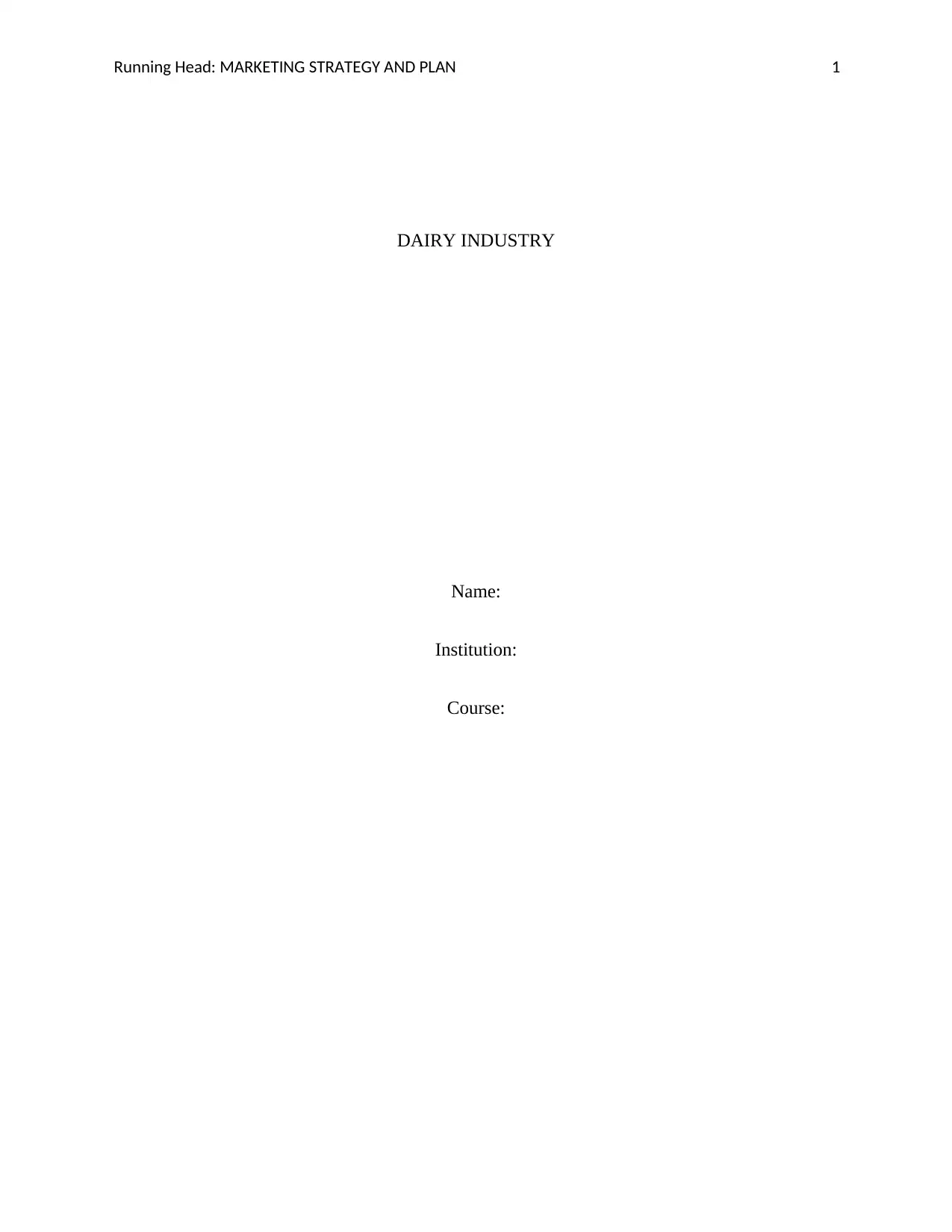
Running Head: MARKETING STRATEGY AND PLAN 1
DAIRY INDUSTRY
Name:
Institution:
Course:
DAIRY INDUSTRY
Name:
Institution:
Course:
Paraphrase This Document
Need a fresh take? Get an instant paraphrase of this document with our AI Paraphraser
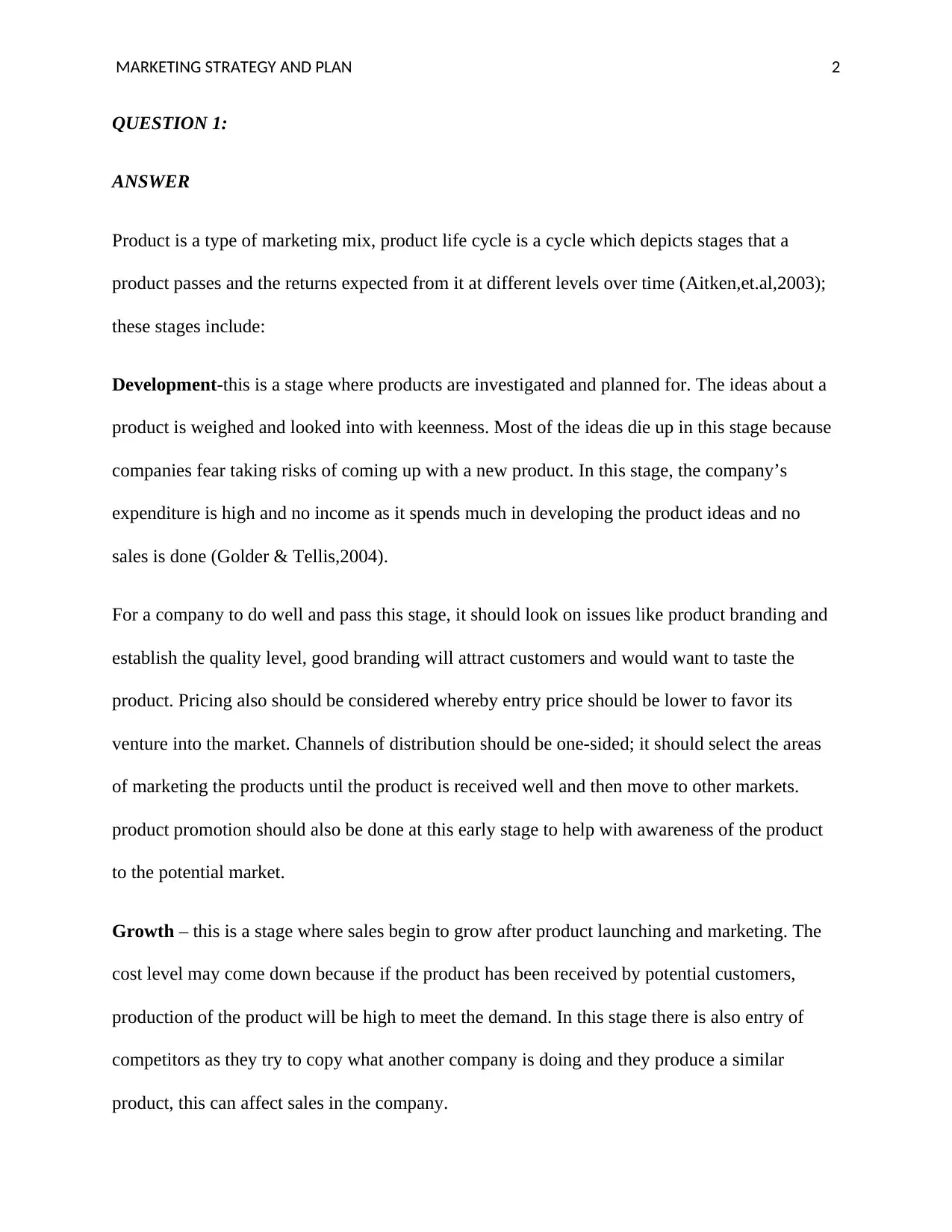
MARKETING STRATEGY AND PLAN 2
QUESTION 1:
ANSWER
Product is a type of marketing mix, product life cycle is a cycle which depicts stages that a
product passes and the returns expected from it at different levels over time (Aitken,et.al,2003);
these stages include:
Development-this is a stage where products are investigated and planned for. The ideas about a
product is weighed and looked into with keenness. Most of the ideas die up in this stage because
companies fear taking risks of coming up with a new product. In this stage, the company’s
expenditure is high and no income as it spends much in developing the product ideas and no
sales is done (Golder & Tellis,2004).
For a company to do well and pass this stage, it should look on issues like product branding and
establish the quality level, good branding will attract customers and would want to taste the
product. Pricing also should be considered whereby entry price should be lower to favor its
venture into the market. Channels of distribution should be one-sided; it should select the areas
of marketing the products until the product is received well and then move to other markets.
product promotion should also be done at this early stage to help with awareness of the product
to the potential market.
Growth – this is a stage where sales begin to grow after product launching and marketing. The
cost level may come down because if the product has been received by potential customers,
production of the product will be high to meet the demand. In this stage there is also entry of
competitors as they try to copy what another company is doing and they produce a similar
product, this can affect sales in the company.
QUESTION 1:
ANSWER
Product is a type of marketing mix, product life cycle is a cycle which depicts stages that a
product passes and the returns expected from it at different levels over time (Aitken,et.al,2003);
these stages include:
Development-this is a stage where products are investigated and planned for. The ideas about a
product is weighed and looked into with keenness. Most of the ideas die up in this stage because
companies fear taking risks of coming up with a new product. In this stage, the company’s
expenditure is high and no income as it spends much in developing the product ideas and no
sales is done (Golder & Tellis,2004).
For a company to do well and pass this stage, it should look on issues like product branding and
establish the quality level, good branding will attract customers and would want to taste the
product. Pricing also should be considered whereby entry price should be lower to favor its
venture into the market. Channels of distribution should be one-sided; it should select the areas
of marketing the products until the product is received well and then move to other markets.
product promotion should also be done at this early stage to help with awareness of the product
to the potential market.
Growth – this is a stage where sales begin to grow after product launching and marketing. The
cost level may come down because if the product has been received by potential customers,
production of the product will be high to meet the demand. In this stage there is also entry of
competitors as they try to copy what another company is doing and they produce a similar
product, this can affect sales in the company.
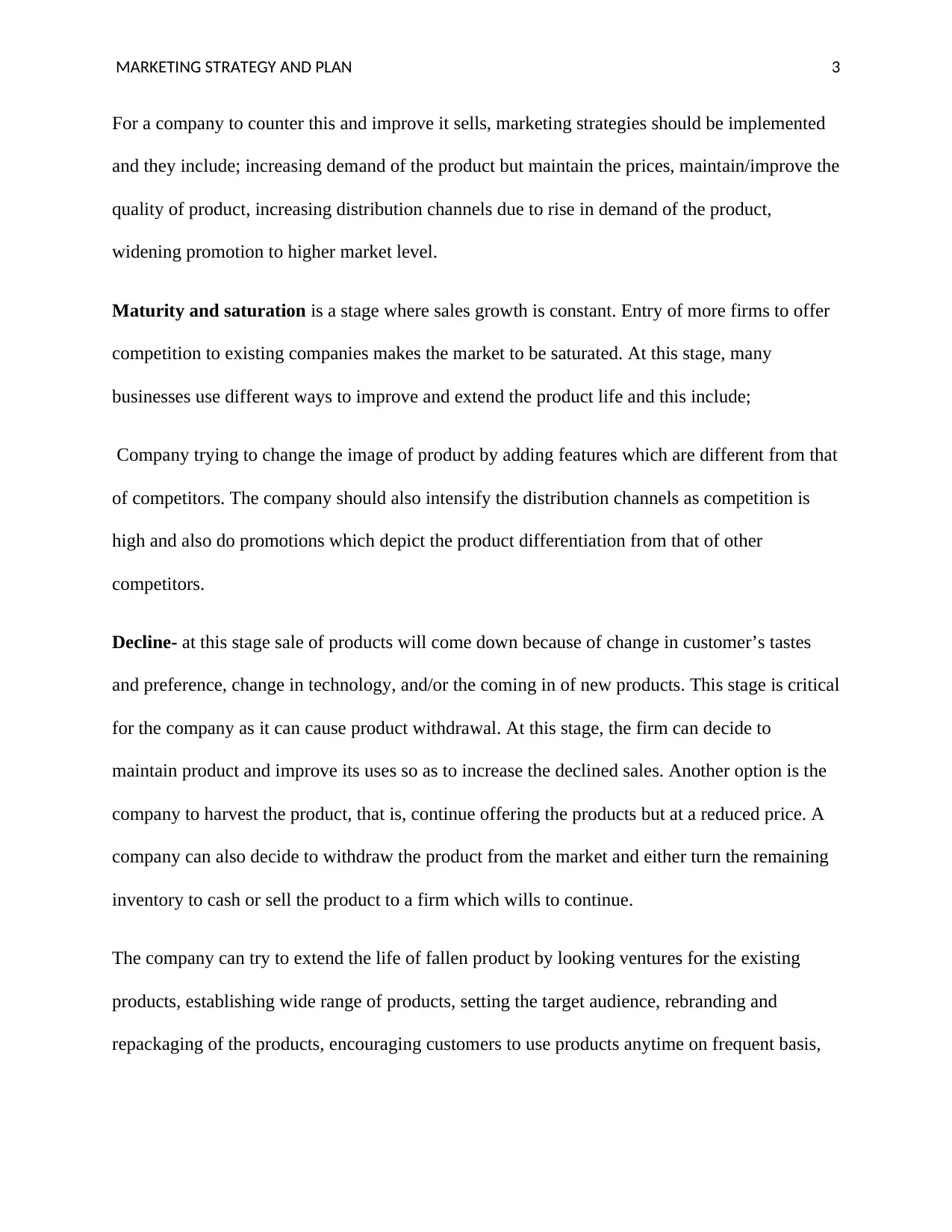
MARKETING STRATEGY AND PLAN 3
For a company to counter this and improve it sells, marketing strategies should be implemented
and they include; increasing demand of the product but maintain the prices, maintain/improve the
quality of product, increasing distribution channels due to rise in demand of the product,
widening promotion to higher market level.
Maturity and saturation is a stage where sales growth is constant. Entry of more firms to offer
competition to existing companies makes the market to be saturated. At this stage, many
businesses use different ways to improve and extend the product life and this include;
Company trying to change the image of product by adding features which are different from that
of competitors. The company should also intensify the distribution channels as competition is
high and also do promotions which depict the product differentiation from that of other
competitors.
Decline- at this stage sale of products will come down because of change in customer’s tastes
and preference, change in technology, and/or the coming in of new products. This stage is critical
for the company as it can cause product withdrawal. At this stage, the firm can decide to
maintain product and improve its uses so as to increase the declined sales. Another option is the
company to harvest the product, that is, continue offering the products but at a reduced price. A
company can also decide to withdraw the product from the market and either turn the remaining
inventory to cash or sell the product to a firm which wills to continue.
The company can try to extend the life of fallen product by looking ventures for the existing
products, establishing wide range of products, setting the target audience, rebranding and
repackaging of the products, encouraging customers to use products anytime on frequent basis,
For a company to counter this and improve it sells, marketing strategies should be implemented
and they include; increasing demand of the product but maintain the prices, maintain/improve the
quality of product, increasing distribution channels due to rise in demand of the product,
widening promotion to higher market level.
Maturity and saturation is a stage where sales growth is constant. Entry of more firms to offer
competition to existing companies makes the market to be saturated. At this stage, many
businesses use different ways to improve and extend the product life and this include;
Company trying to change the image of product by adding features which are different from that
of competitors. The company should also intensify the distribution channels as competition is
high and also do promotions which depict the product differentiation from that of other
competitors.
Decline- at this stage sale of products will come down because of change in customer’s tastes
and preference, change in technology, and/or the coming in of new products. This stage is critical
for the company as it can cause product withdrawal. At this stage, the firm can decide to
maintain product and improve its uses so as to increase the declined sales. Another option is the
company to harvest the product, that is, continue offering the products but at a reduced price. A
company can also decide to withdraw the product from the market and either turn the remaining
inventory to cash or sell the product to a firm which wills to continue.
The company can try to extend the life of fallen product by looking ventures for the existing
products, establishing wide range of products, setting the target audience, rebranding and
repackaging of the products, encouraging customers to use products anytime on frequent basis,
⊘ This is a preview!⊘
Do you want full access?
Subscribe today to unlock all pages.

Trusted by 1+ million students worldwide
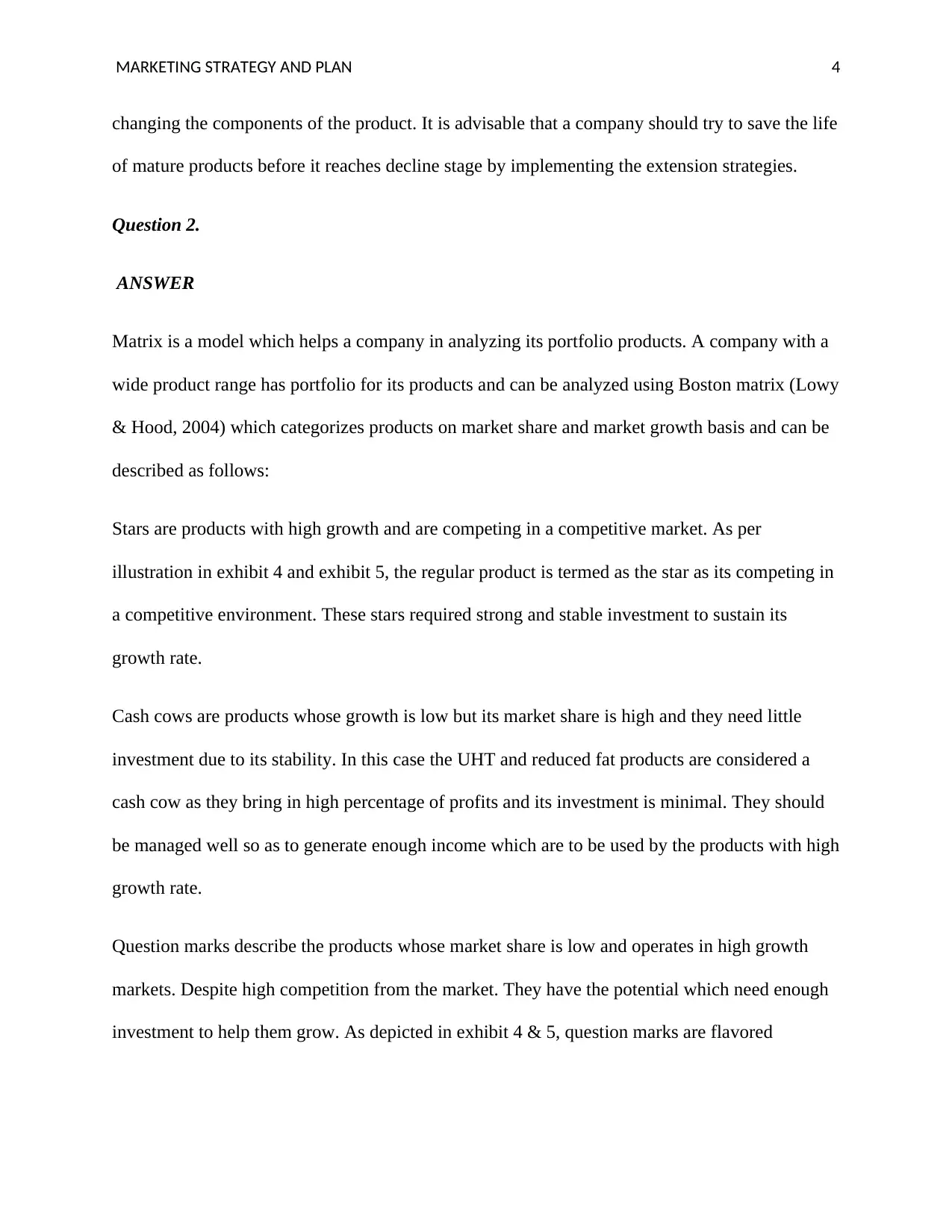
MARKETING STRATEGY AND PLAN 4
changing the components of the product. It is advisable that a company should try to save the life
of mature products before it reaches decline stage by implementing the extension strategies.
Question 2.
ANSWER
Matrix is a model which helps a company in analyzing its portfolio products. A company with a
wide product range has portfolio for its products and can be analyzed using Boston matrix (Lowy
& Hood, 2004) which categorizes products on market share and market growth basis and can be
described as follows:
Stars are products with high growth and are competing in a competitive market. As per
illustration in exhibit 4 and exhibit 5, the regular product is termed as the star as its competing in
a competitive environment. These stars required strong and stable investment to sustain its
growth rate.
Cash cows are products whose growth is low but its market share is high and they need little
investment due to its stability. In this case the UHT and reduced fat products are considered a
cash cow as they bring in high percentage of profits and its investment is minimal. They should
be managed well so as to generate enough income which are to be used by the products with high
growth rate.
Question marks describe the products whose market share is low and operates in high growth
markets. Despite high competition from the market. They have the potential which need enough
investment to help them grow. As depicted in exhibit 4 & 5, question marks are flavored
changing the components of the product. It is advisable that a company should try to save the life
of mature products before it reaches decline stage by implementing the extension strategies.
Question 2.
ANSWER
Matrix is a model which helps a company in analyzing its portfolio products. A company with a
wide product range has portfolio for its products and can be analyzed using Boston matrix (Lowy
& Hood, 2004) which categorizes products on market share and market growth basis and can be
described as follows:
Stars are products with high growth and are competing in a competitive market. As per
illustration in exhibit 4 and exhibit 5, the regular product is termed as the star as its competing in
a competitive environment. These stars required strong and stable investment to sustain its
growth rate.
Cash cows are products whose growth is low but its market share is high and they need little
investment due to its stability. In this case the UHT and reduced fat products are considered a
cash cow as they bring in high percentage of profits and its investment is minimal. They should
be managed well so as to generate enough income which are to be used by the products with high
growth rate.
Question marks describe the products whose market share is low and operates in high growth
markets. Despite high competition from the market. They have the potential which need enough
investment to help them grow. As depicted in exhibit 4 & 5, question marks are flavored
Paraphrase This Document
Need a fresh take? Get an instant paraphrase of this document with our AI Paraphraser
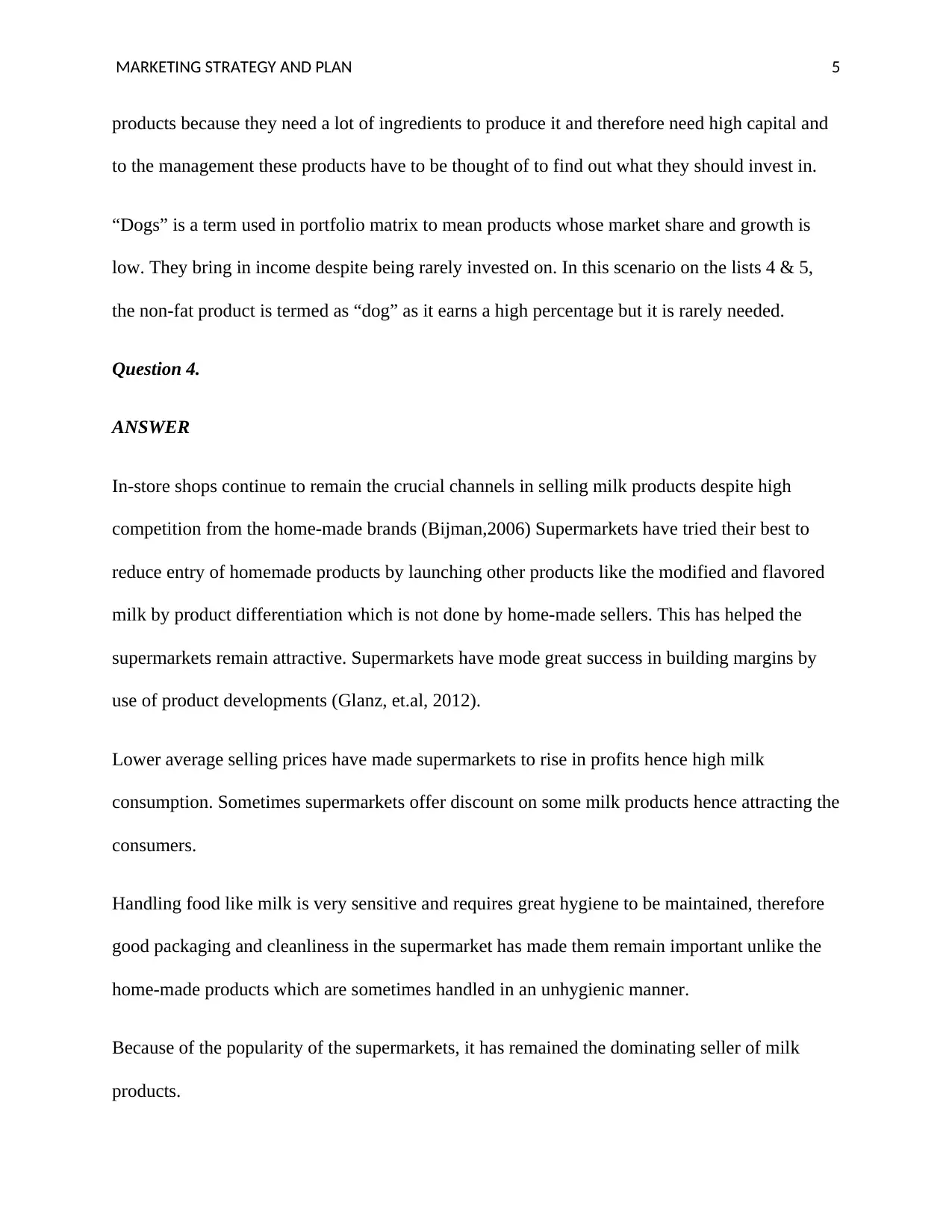
MARKETING STRATEGY AND PLAN 5
products because they need a lot of ingredients to produce it and therefore need high capital and
to the management these products have to be thought of to find out what they should invest in.
“Dogs” is a term used in portfolio matrix to mean products whose market share and growth is
low. They bring in income despite being rarely invested on. In this scenario on the lists 4 & 5,
the non-fat product is termed as “dog” as it earns a high percentage but it is rarely needed.
Question 4.
ANSWER
In-store shops continue to remain the crucial channels in selling milk products despite high
competition from the home-made brands (Bijman,2006) Supermarkets have tried their best to
reduce entry of homemade products by launching other products like the modified and flavored
milk by product differentiation which is not done by home-made sellers. This has helped the
supermarkets remain attractive. Supermarkets have mode great success in building margins by
use of product developments (Glanz, et.al, 2012).
Lower average selling prices have made supermarkets to rise in profits hence high milk
consumption. Sometimes supermarkets offer discount on some milk products hence attracting the
consumers.
Handling food like milk is very sensitive and requires great hygiene to be maintained, therefore
good packaging and cleanliness in the supermarket has made them remain important unlike the
home-made products which are sometimes handled in an unhygienic manner.
Because of the popularity of the supermarkets, it has remained the dominating seller of milk
products.
products because they need a lot of ingredients to produce it and therefore need high capital and
to the management these products have to be thought of to find out what they should invest in.
“Dogs” is a term used in portfolio matrix to mean products whose market share and growth is
low. They bring in income despite being rarely invested on. In this scenario on the lists 4 & 5,
the non-fat product is termed as “dog” as it earns a high percentage but it is rarely needed.
Question 4.
ANSWER
In-store shops continue to remain the crucial channels in selling milk products despite high
competition from the home-made brands (Bijman,2006) Supermarkets have tried their best to
reduce entry of homemade products by launching other products like the modified and flavored
milk by product differentiation which is not done by home-made sellers. This has helped the
supermarkets remain attractive. Supermarkets have mode great success in building margins by
use of product developments (Glanz, et.al, 2012).
Lower average selling prices have made supermarkets to rise in profits hence high milk
consumption. Sometimes supermarkets offer discount on some milk products hence attracting the
consumers.
Handling food like milk is very sensitive and requires great hygiene to be maintained, therefore
good packaging and cleanliness in the supermarket has made them remain important unlike the
home-made products which are sometimes handled in an unhygienic manner.
Because of the popularity of the supermarkets, it has remained the dominating seller of milk
products.
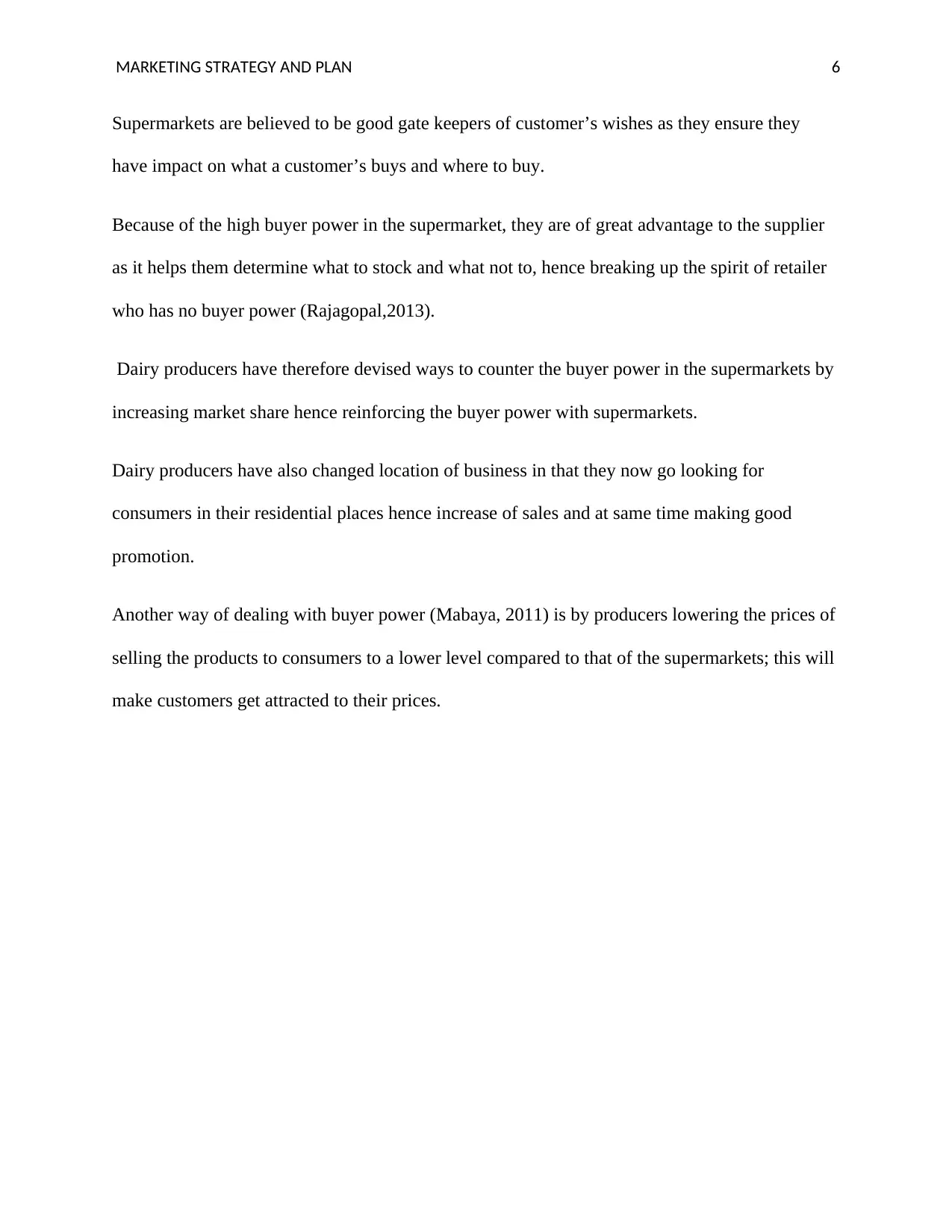
MARKETING STRATEGY AND PLAN 6
Supermarkets are believed to be good gate keepers of customer’s wishes as they ensure they
have impact on what a customer’s buys and where to buy.
Because of the high buyer power in the supermarket, they are of great advantage to the supplier
as it helps them determine what to stock and what not to, hence breaking up the spirit of retailer
who has no buyer power (Rajagopal,2013).
Dairy producers have therefore devised ways to counter the buyer power in the supermarkets by
increasing market share hence reinforcing the buyer power with supermarkets.
Dairy producers have also changed location of business in that they now go looking for
consumers in their residential places hence increase of sales and at same time making good
promotion.
Another way of dealing with buyer power (Mabaya, 2011) is by producers lowering the prices of
selling the products to consumers to a lower level compared to that of the supermarkets; this will
make customers get attracted to their prices.
Supermarkets are believed to be good gate keepers of customer’s wishes as they ensure they
have impact on what a customer’s buys and where to buy.
Because of the high buyer power in the supermarket, they are of great advantage to the supplier
as it helps them determine what to stock and what not to, hence breaking up the spirit of retailer
who has no buyer power (Rajagopal,2013).
Dairy producers have therefore devised ways to counter the buyer power in the supermarkets by
increasing market share hence reinforcing the buyer power with supermarkets.
Dairy producers have also changed location of business in that they now go looking for
consumers in their residential places hence increase of sales and at same time making good
promotion.
Another way of dealing with buyer power (Mabaya, 2011) is by producers lowering the prices of
selling the products to consumers to a lower level compared to that of the supermarkets; this will
make customers get attracted to their prices.
⊘ This is a preview!⊘
Do you want full access?
Subscribe today to unlock all pages.

Trusted by 1+ million students worldwide
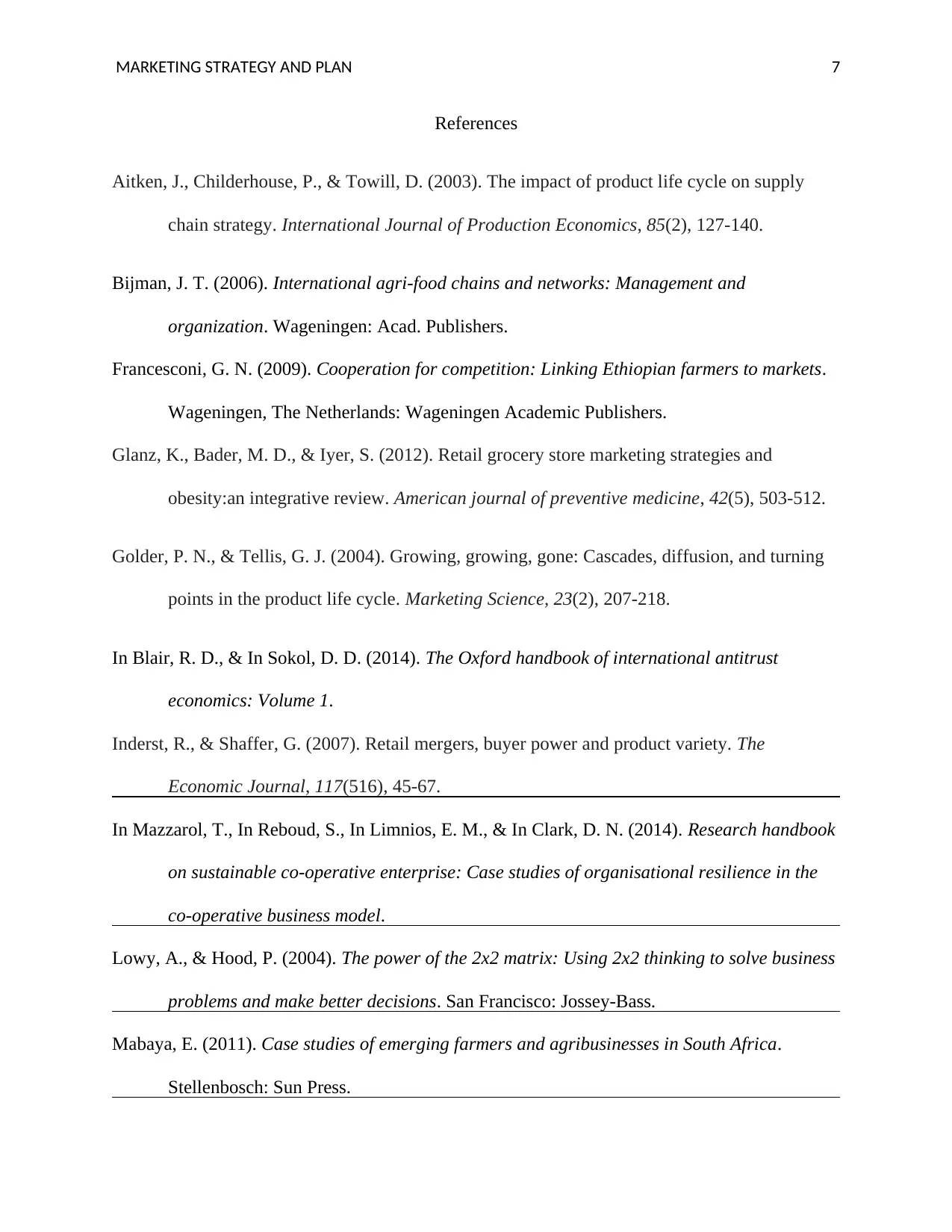
MARKETING STRATEGY AND PLAN 7
References
Aitken, J., Childerhouse, P., & Towill, D. (2003). The impact of product life cycle on supply
chain strategy. International Journal of Production Economics, 85(2), 127-140.
Bijman, J. T. (2006). International agri-food chains and networks: Management and
organization. Wageningen: Acad. Publishers.
Francesconi, G. N. (2009). Cooperation for competition: Linking Ethiopian farmers to markets.
Wageningen, The Netherlands: Wageningen Academic Publishers.
Glanz, K., Bader, M. D., & Iyer, S. (2012). Retail grocery store marketing strategies and
obesity:an integrative review. American journal of preventive medicine, 42(5), 503-512.
Golder, P. N., & Tellis, G. J. (2004). Growing, growing, gone: Cascades, diffusion, and turning
points in the product life cycle. Marketing Science, 23(2), 207-218.
In Blair, R. D., & In Sokol, D. D. (2014). The Oxford handbook of international antitrust
economics: Volume 1.
Inderst, R., & Shaffer, G. (2007). Retail mergers, buyer power and product variety. The
Economic Journal, 117(516), 45-67.
In Mazzarol, T., In Reboud, S., In Limnios, E. M., & In Clark, D. N. (2014). Research handbook
on sustainable co-operative enterprise: Case studies of organisational resilience in the
co-operative business model.
Lowy, A., & Hood, P. (2004). The power of the 2x2 matrix: Using 2x2 thinking to solve business
problems and make better decisions. San Francisco: Jossey-Bass.
Mabaya, E. (2011). Case studies of emerging farmers and agribusinesses in South Africa.
Stellenbosch: Sun Press.
References
Aitken, J., Childerhouse, P., & Towill, D. (2003). The impact of product life cycle on supply
chain strategy. International Journal of Production Economics, 85(2), 127-140.
Bijman, J. T. (2006). International agri-food chains and networks: Management and
organization. Wageningen: Acad. Publishers.
Francesconi, G. N. (2009). Cooperation for competition: Linking Ethiopian farmers to markets.
Wageningen, The Netherlands: Wageningen Academic Publishers.
Glanz, K., Bader, M. D., & Iyer, S. (2012). Retail grocery store marketing strategies and
obesity:an integrative review. American journal of preventive medicine, 42(5), 503-512.
Golder, P. N., & Tellis, G. J. (2004). Growing, growing, gone: Cascades, diffusion, and turning
points in the product life cycle. Marketing Science, 23(2), 207-218.
In Blair, R. D., & In Sokol, D. D. (2014). The Oxford handbook of international antitrust
economics: Volume 1.
Inderst, R., & Shaffer, G. (2007). Retail mergers, buyer power and product variety. The
Economic Journal, 117(516), 45-67.
In Mazzarol, T., In Reboud, S., In Limnios, E. M., & In Clark, D. N. (2014). Research handbook
on sustainable co-operative enterprise: Case studies of organisational resilience in the
co-operative business model.
Lowy, A., & Hood, P. (2004). The power of the 2x2 matrix: Using 2x2 thinking to solve business
problems and make better decisions. San Francisco: Jossey-Bass.
Mabaya, E. (2011). Case studies of emerging farmers and agribusinesses in South Africa.
Stellenbosch: Sun Press.
Paraphrase This Document
Need a fresh take? Get an instant paraphrase of this document with our AI Paraphraser
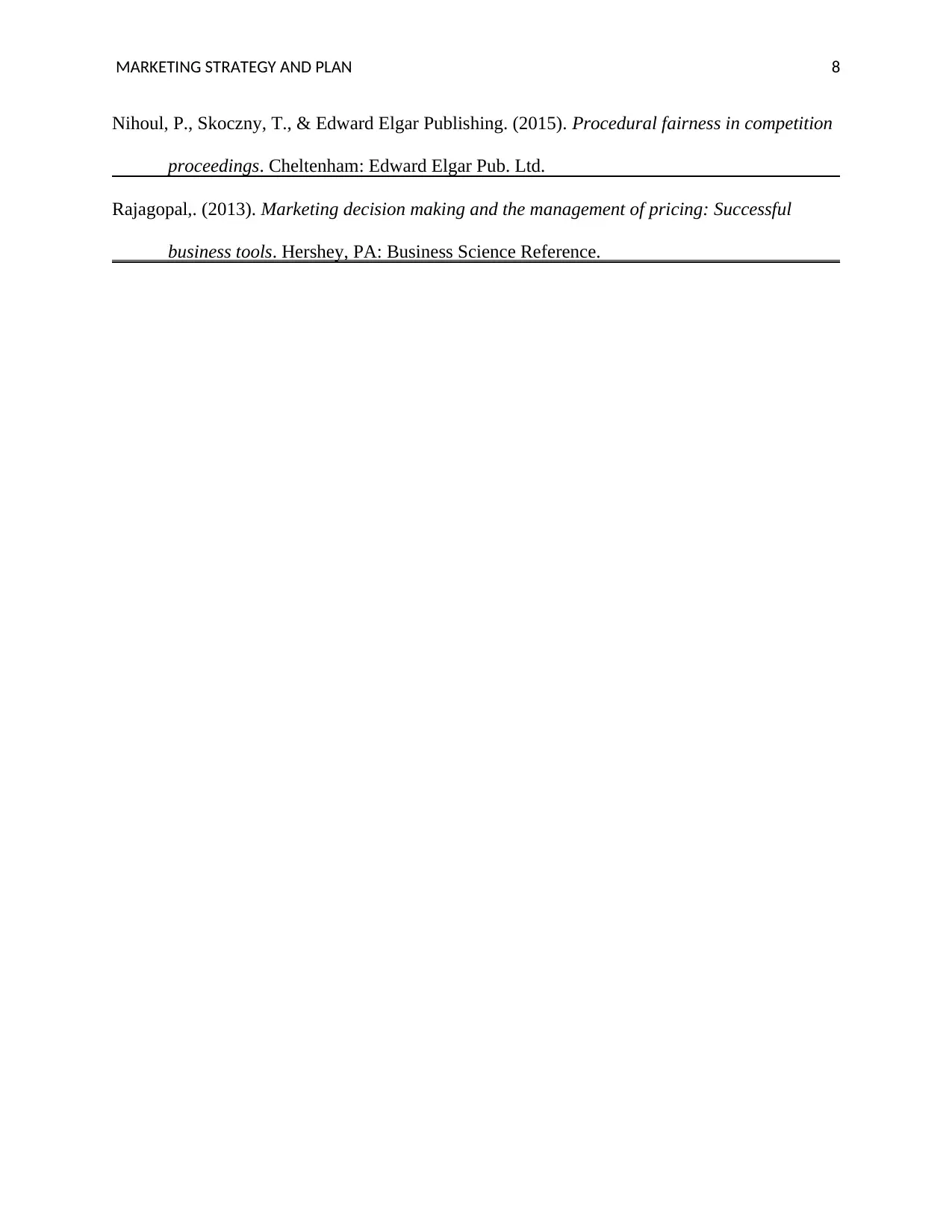
MARKETING STRATEGY AND PLAN 8
Nihoul, P., Skoczny, T., & Edward Elgar Publishing. (2015). Procedural fairness in competition
proceedings. Cheltenham: Edward Elgar Pub. Ltd.
Rajagopal,. (2013). Marketing decision making and the management of pricing: Successful
business tools. Hershey, PA: Business Science Reference.
Nihoul, P., Skoczny, T., & Edward Elgar Publishing. (2015). Procedural fairness in competition
proceedings. Cheltenham: Edward Elgar Pub. Ltd.
Rajagopal,. (2013). Marketing decision making and the management of pricing: Successful
business tools. Hershey, PA: Business Science Reference.
1 out of 8
Related Documents
Your All-in-One AI-Powered Toolkit for Academic Success.
+13062052269
info@desklib.com
Available 24*7 on WhatsApp / Email
![[object Object]](/_next/static/media/star-bottom.7253800d.svg)
Unlock your academic potential
Copyright © 2020–2025 A2Z Services. All Rights Reserved. Developed and managed by ZUCOL.





